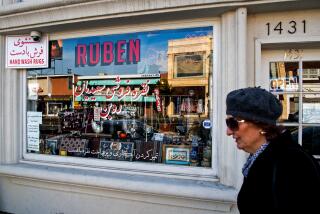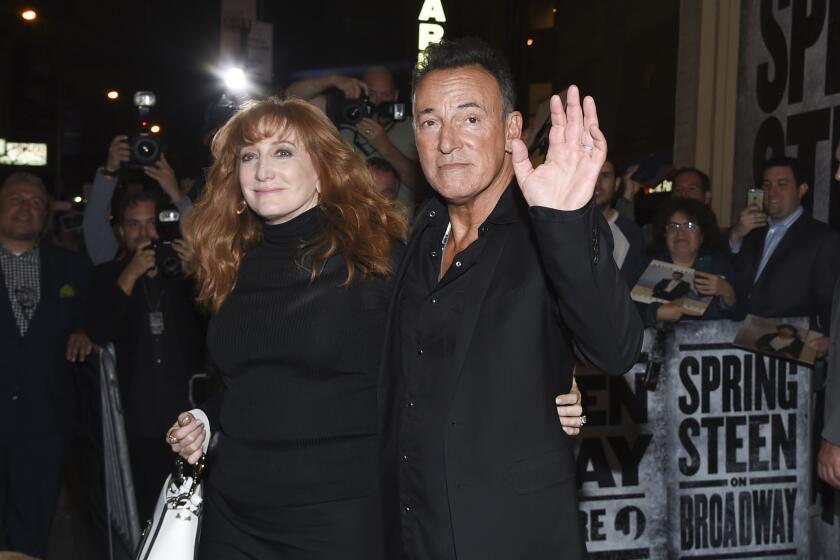Stop Stereotyping Arabs and Iranians
I was glad to see that in their articles on the movie “Not Without My Daughter,” Times staff writer Nina Easton (Jan. 10) and film critic Sheila Benson (Jan. 11) so accurately addressed the apprehension felt by Middle Eastern communities in the United States over how such movies reinforce prejudice against Arabs and Iranians.
The eruption of war in Iraq and its possible expansion to the whole Middle East heightens the misunderstanding that this movie perpetuates. As an Iranian-American woman, an active advocate of women’s rights and a scholar in exile, I naturally have empathy with and sympathy for the sufferings and frustrations that Betty Mahmoody (co-author of the book that is the basis of the movie) went through in Iran.
I certainly condemn the suppressive and violent treatment of Betty by her Iranian husband. I believe Betty has the right and responsibility to tell her story, even though, unfortunately, her written story is negatively one-sided and reflects a strong generalized hatred toward Iranians. I welcome, however, her joining the campaign against violence against women, which is not, incidentally, less prevalent in Judeo-Christian America than in the Islamic Middle East.
But the movie is an unbalanced and distorted representation of Iranians and Iranian culture in general. It fails to distinguish between the state and the people. No clear differentiation is made between the policies and attitudes of the extremist Islamic members or supporters of the present ruling subculture and those of other groups of Iranians.
Why is it that only the negative, extremist or exotic aspects of Middle Eastern cultures become the focus of films or that these aspects become so exaggerated and sensationalized that they exacerbate, and even encourage, the hostile political mood of the day, in particular anti-Arab and anti-Iranian sentiments?
For years now, the West’s impression of Middle Eastern women has been developed through movies and television that simplistically perpetuate stereotypes. Why are most Middle Eastern women depicted as little more than creatures of the harem--those exotic and mysterious odalisques--veiled enigmas or invisible beasts of burden? “Not Without My Daughter” continues this longstanding “tradition” precisely at a time when we need films that provide fully dimensional portraits of people from all cultures. Films that offer true pictures of people--whether in fictional or docudrama accounts--can still be good, powerful, dramatic films.
Acceptance of stereotypical images of Middle Eastern women--perpetuated by films and television--is far too pervasive, even among educated Americans. I notice this lack of understanding of Middle Eastern cultures whenever I give a lecture on Middle Eastern women or when I start to teach a class. Many of my students are surprised to learn that I am originally from Iran and received my degree in higher education from the University of Tehran. In actuality, I represent a rapidly growing, highly educated class of professional women in Iran. But anyone watching American films would never know that.
My own longtime involvement in researching and campaigning against the second-class status of women throughout the world--particularly the oppressive and patriarchal traditions in Iran reinforced by the retrogressive policies of the current Islamic government--has clearly distanced me from the apologists of the status quo in the Middle East.
By selectively concentrating on Betty’s experience as a white middle-class American woman trapped and victimized by Iranians and not depicting any Iranian women similarly victimized, the filmmakers reinforce the narrow view of “civilized Americans” versus “savage Middle Easterners.” The movie depicts so few likable Iranian women and men that filmgoers cannot be blamed if they see nothing positive about Iranian culture and emerge with yet another Amero-centric point of view.
I would have welcomed a critical exposure of the negative features of Iranian culture--or any culture--regarding the lack of democracy, the violations of human rights in general and women’s rights in particular.
“Not Without My Daughter” does not serve that purpose. It instead puts down not only Iranian men and Iranian culture in general but Iranian women as well. The Iranian characters are portrayed in the abstract and are isolated from their history and political and social-psychological contexts.
The movies fails, for example, to explain how and why Betty’s Iranian husband goes through such an apparently abrupt change from decent father and loving husband to fiend once he is home again. Such an unreal and simplistic portrayal of the main character indicates the filmmakers’ lack of knowledge and understanding of Iranian culture and the Iranian psyche.
Finally, one cannot help but wonder why the plight of millions of Iranian women (and men) who have been persecuted, imprisoned, tortured or forced to leave their homeland--because of their opposition to the very human-rights violations, sexism and extremism that are depicted in this movie--has never become the basis of such a widely publicized Hollywood production.
Do we care about the violation of human rights and violence against women only when it is committed against “us” by non-American “others”?
More to Read
Only good movies
Get the Indie Focus newsletter, Mark Olsen's weekly guide to the world of cinema.
You may occasionally receive promotional content from the Los Angeles Times.










